Overview of the elements
Contents
 Aether
Aether 
Aether encompasses space, electricity, and perfection. As an element, Aether has much to offer, with powerful immortal creatures, and some of the best control in the game. As of patch 1.31, Aether now has now gained much more speed with Psion or upgraded, Phase Spider, putting it as almost a perfect balance of defense, offense, control, and speed. While Aether cards are very powerful, Aether lacks permanent control to deal with annoying permanents, and the powerful cards that it has are often expensive, making it a slightly slower powerhouse.
Cards worthy of note: Lobotomizer, Lightning, Fractal, Parallel Universe, Immortal, Dimensional Shield
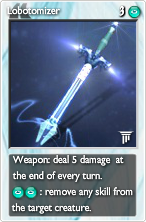


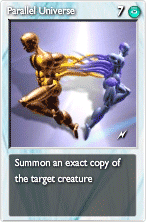
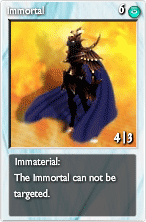
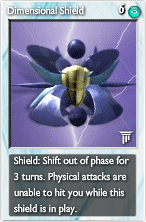
Lobotomizer: Very powerful reusable control. A single one can shut down entire enemy decks based on creatures with abilities, such as Firefly Queen or Lava Golem. Used in the False God grinder RoL/Hope.
Lightning: One of the strongest instant control cards in the game. 5 damage to any creature or player for 2 ![]() is nothing to laugh at. Many creatures in the game will fall to a single lightning.
is nothing to laugh at. Many creatures in the game will fall to a single lightning.
Fractal: A unique card that allows its user to far surpass the 6 creature limit in a deck. Because of this, Aether has the ability to use spam multiple copies of cheap creatures for massive damage, or in RoL/Hope with Rays of Light to create a massive shield.
Parallel Universe: Allows a player to instantly double the pain by making a copy of any single creature on the field, be it your own Shrieker, or an opponent's damager. While costly, the immense potential that this card packs is more than worth it in a large number of decks.
Immortal: Even Aether's creatures have a sense of perfection about them. The Immortal (as well as Phase Dragon) is Aether's creature of choice in a balance of offense and defense. With decent attack and being invulnerable, they would be ideal if it only weren't for their high cost. Aether players who want faster damage may want to consider Psion, or when upgrades, Phase Recluse. One who wants the power of immortality on other creatures may want to consider the handy spell, Quintessence.
Dimensional Shield: Perhaps one of the most notorious cards in the game. This allows its users to avoid all physical damage for 3 turns. If an opponent doesn't have any permanent control or alternate damage, to deal with this, a match can quickly be turned in the favor of the dim shield user.
 Air
Air 
Air is the element of fluidity and gracefulness. While Air may not have the highest offense or the best control, the element of Air provides much flexibility and defense in the form of two very powerful shields. In contrast to the brutal offense offered by some other elements, Air’s main form of offense focuses more on skills and interesting abilities.
Cards worthy of note: Wyrm, Firefly Queen, Owls Eye, Wings, Flying Weapon, Unstable Gas

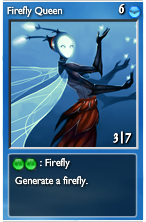
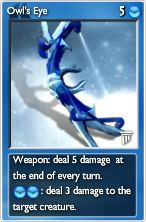


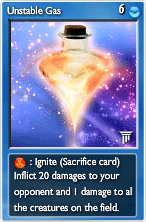
Wyrm: Besides the expensive Azure Dragon, Air's main form of offense comes from Wyrm. Wyrm has the ability to dive, doubling its attack, so buff cards work best on it. Upgraded, it can do an astounding 10 damage per turn, on par with a dragon's damage output. If one likes the dive concept, one can dive all airborne creatures for a turn with Sky Blitz.
Firefly Queen: Almost Air's signature card. FFQ has also received a buff in recent patches, making it cost only 6 ![]() instead of 7
instead of 7 ![]() . With some
. With some ![]() quanta investment, FFQ can quickly ramp up the damage by producing a Firefly every single turn.
quanta investment, FFQ can quickly ramp up the damage by producing a Firefly every single turn.
Owl's Eye: What makes Air's elemental weapon one of the most feared in the game? In addition to its damage output, an Owl's Eye has the ability to snipe a creature for 3 damage each turn, a very powerful reusable creature control. If one wants faster, cheaper, and one time use creature control, there is also Shockwave and Thunderstorm, but those are not as powerful as Lightning or Rain of Fire.
Wings: Shields. Air has two of the best in the game. The first is Wings, a five turn shield that blocks all non-airborne creatures from attacking the user. This by itself is a card that blocks around two thirds of all creatures in the game, but its long cost and affordability make it great. Another great fact about Wings is that even if it is stolen, an Air user has nothing to fear as all of air's creatures (besides the nymph) are airborne and can hit past it. Fog Shield is another marvelous shield that blocks 40% of all damage for a very cheap cost of 2 ![]() .
.
Flying Weapon: Flying weapon is a unique card that for 1 ![]() (:rainbow if upgraded) allows a player to break the 1 weapon at a time rule. By flying out weapons, one can have multiple Owl's Eyes sniping down the field, an invincible Morning Glory, or mass Druidic Staff for plenty of healing. Flying Weapon is a very flexible card for weapon lovers and can be splashed with a simple
(:rainbow if upgraded) allows a player to break the 1 weapon at a time rule. By flying out weapons, one can have multiple Owl's Eyes sniping down the field, an invincible Morning Glory, or mass Druidic Staff for plenty of healing. Flying Weapon is a very flexible card for weapon lovers and can be splashed with a simple ![]() mark if needed.
mark if needed.
Unstable Gas: A "bomb" card that can be detonated for quite a cost investment. In return, all creatures on the field take one damage, adding more to air's creature control capabilities, but the biggest advantage of detonating this is that the opponent instantly takes 20 damage, one fifth of their entire health bar. Unstable gas can be powered with a ![]() mark, Immolation, or even an upgraded Firefly. Be warned that Mirror Shield will reflect UG explosions.
mark, Immolation, or even an upgraded Firefly. Be warned that Mirror Shield will reflect UG explosions.
 Darkness
Darkness 
Darkness is a very sneaky and powerful element. Instead of outright brute strength or powerful abilities, Darkness prefers to use sly skills to slowly undermine the enemies' defenses while slowly building up its own strength. The element of Darkness thus has many cards that work by the concept of stealing, stealing the opponent's health, quanta, hand space, and permanents for its own use. Darkness is also one of the few elements that is complete, having nearly every single form of control and protection available, making it one of the stronger elements.
Cards worthy of note: Devourer, Minor Vampire, Steal, Voodoo Doll, Nightmare, Cloak


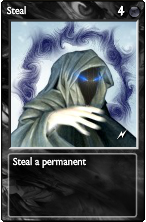
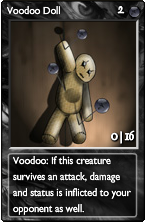

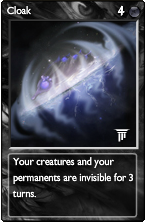
Devourer: This pest is not to be underestimated. While it doesn't have any attack, Devourers are very annoying creatures for the opponent because of their innate passive ability (that can't be lobotomized) that drains 1 random quanta each turn and give the owner 1 ![]() . Few players would want to waste a powerful control card like Lightning to get rid of one, which makes these creatures that slowly drain the opponent. The Devourer is quite frail at 0|2, but it has the ability to burrow to be untargettable. A marvelous combination with this card is Fractal or Mitosis for more quanta draining, but the best combination would probably be Nightfall. Nightfall allows this quanta drainer to actually deal damage, and Devourer keeps the same attack Nightfall bestows while burrowed, making into an invincible, quanta-draining attacker.
. Few players would want to waste a powerful control card like Lightning to get rid of one, which makes these creatures that slowly drain the opponent. The Devourer is quite frail at 0|2, but it has the ability to burrow to be untargettable. A marvelous combination with this card is Fractal or Mitosis for more quanta draining, but the best combination would probably be Nightfall. Nightfall allows this quanta drainer to actually deal damage, and Devourer keeps the same attack Nightfall bestows while burrowed, making into an invincible, quanta-draining attacker.
Minor Vampire: Another card that exemplifies Darkness' niche of stealing. Minor Vampire is a card that both damages the opponent, and heals the user. While these creatures are pretty frail, when paired up with the denial mechanics of its own element like Devourer or Nightmare, vampires can quickly get out of hand. These work best with buff cards like Blessing or Nightfall. Vampire Stiletto is the elemental weapon of darkness, and it is regarded as being one of the best weapons in the game for its efficiency. For 1|2 ![]() , it has a vampiric attack of 4|6, making it possible to leave a damage gap of 12 each turn from a single 2 quanta weapon.
, it has a vampiric attack of 4|6, making it possible to leave a damage gap of 12 each turn from a single 2 quanta weapon.
Steal: There's nothing really special to say about Steal, but for only 1 more quanta than Deflagration, a user of Steal destroys an opponent permanent and gains the permanent for themselves, essentially gaining a 2 permanent advantage over their opponent.
Voodoo Doll: Voodoo Doll is an example of the subtle, yet effective abilities Darkness has. Any negative effect inflicted on the doll applies to the opponent, so these can be used as deterrent for creature control happy opponents. While this creature doesn't work great by itself, it opens up a lot of combinations with other cards that lead to specialized decks. Synergizes great with Pandemonium, Liquid Shadow, and Rage Potion.
Nightmare: Nightmare once again shows how Darkness players can use the opponent's cards against them. Nightmare is a spell that bypasses shields, and fills up the opponent's hand with target copies of a creature, draining 2 hp per card given. In this way, Nightmare has a variety of functions. Filling the opponent's hand with a card like Devourer will most likely be a dead card to the opponent, denying them of their next draw, and stuffing their hand so cards like Fractal and Golden Hourglass will no longer be as effective. Nightmare is also a rush-stopper, as if used against an opponent with an empty hand, 16 hp will be drained from the opponent to the user. One must be cautious when using Nightmare to make sure that the creatures given to the opponent won't help the opponent. Works great with Ghost of the Past, but completely countered by Sanctuary.
Cloak: Darkness' defensive capabilities have often been ignored, but Cloak is a powerful card. Cloak protects a player's permanents and creatures from being targetted for 3 turns, or when Cloak is removed. Be warned that Cloak disappears whenever any mass CC card is played, such as Thunderstorm, Pandemonium, Rain of Fire, and Plague.
 Death
Death 
The element of Death is deadly indeed. While it seems at a glance weaker than some of the other elements for its reliance on death effects, Death is actually a very powerful element with strong offense and defensive capabilities. While it doesn't have any permanent control, Death users often rely on Poison damage to slip through the opponent's shield and slowly kill the opponent.
Cards worthy of note: Poison, Mummy, Aflatoxin, Bone Wall, Arsenic, Boneyard

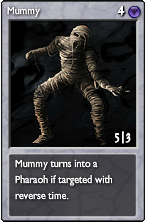


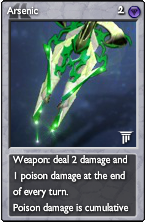
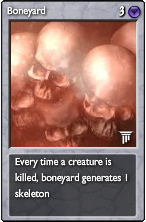
Poison: Don't overlook poison. For the cheap price of 1 ![]() , it deals a quite efficient 2 damage per turn that bypasses shields. A very efficient killing gem in Death's arsenal. Upgraded, it costs 2
, it deals a quite efficient 2 damage per turn that bypasses shields. A very efficient killing gem in Death's arsenal. Upgraded, it costs 2 ![]() , but the poison is now 3 per turn. Be wary of Water users who have Purify.
, but the poison is now 3 per turn. Be wary of Water users who have Purify.
Mummy: Mummy is Death's mid range hitter of choice, and for good reason. 4 quanta for a 5|3 creature makes it one of the most efficient unupped creatures in the game (the other being GotP). Mummy also comes with its own Reverse Time deterrent, if targetted with that spell, it instantly becomes a Pharaoh, sort of like how a Skeleton targetted by RT becomes a random creature. In the upgraded game, upped Flesh Spiders are better choices for mid range damage dealing.
Aflatoxin: Aflatoxin is a peculiar card that acts as creature control for Death. However, once the aflatoxin'd creature dies (in a few turns because it takes 2 damage per turn), instead of just dying, a Malignant Cell is generated. Malignant cells can be used both offensively as a quick field filler, or defensively to lock down the opponent's field or to combo with Empathic Bond. Aflatoxin is a tricky card to use, but when used correctly, it can be very powerful.
Bone Wall: Death's shields are along with Air's, some of the strongest in the game. Bone Wall is a shield card that generates seven bone wall counters, blocking the next seven physical attacks from the opponent, no matter how much damage they do. A single bonewall counter blocks a 1|1 Photon just as it would a 12|3 Crimson Dragon. Bonewall counters are gained in increments of 2 for every death effect triggered, making Schrodingers Cat a great card to pair along with Bonewall. Skull Shield is Death's other powerful shield, that in addition to blocking 1 damage, has a chance to turn opposing creatures into skeletons. There's nothing quite as satisfying as seeing a 5|1 Lava Golem suddenly turn into a useless 1|1 Skeleton.
Arsenic: Perhaps the stiletto's rival, Arsenic is a cheap, sneaky weapon for 2 ![]() . It deals 2|4 damage per turn, but every single successful hit adds one poison counter to the opponent, leading up to quite a build up of damage over time.
. It deals 2|4 damage per turn, but every single successful hit adds one poison counter to the opponent, leading up to quite a build up of damage over time.
Boneyard: Boneyard is the offensive version of Bonewall. Instead of being a shield, a Boneyard creates a skeleton every single death effect. WIth lots of cats, one can quickly get themselves a large field of fodder creatures that can be used for Immolation, Mutation, or healing with bonds. Nightfall can also be considered for a massive boost in damage.
 Earth
Earth 
Earth is the element of tenacity and resistance, a bulky element that has a more defensive play style. Earth carries some light creature control, as well as permanent control (though it requires some ![]() quanta) and powerful creatures. Definitely not the fastest or most brutal rush, Earth can nonetheless hold its own in a battle. The defensive cards of Earth however, make it seem more oriented towards a stall deck, with its massive amounts of defense.
quanta) and powerful creatures. Definitely not the fastest or most brutal rush, Earth can nonetheless hold its own in a battle. The defensive cards of Earth however, make it seem more oriented towards a stall deck, with its massive amounts of defense.
Cards worthy of note: Graboid, Enchant Artifact, Pulverizer, Iridium Warden, Earthquake, Stone Skin
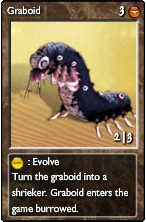
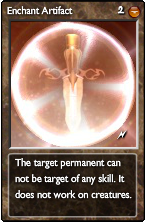
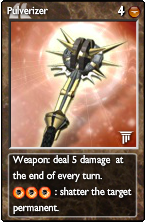

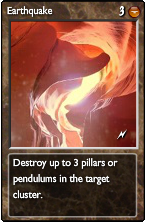
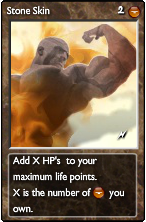
Graboid: A very deadly card. Not only does Graboid enter play burrowed and unable to be targetted, but in just one turn and 1 ![]() , it can evolve into a Shrieker, a powerful creature whose offensive abilities are the same as Earth's dragon. While it doesn't have Stone Dragon's high hp, a Shrieker costs less to play and can burrow, rendering itself invincible. Graboid is a very cheap and powerful card, often the backbone of Earth's offense.
, it can evolve into a Shrieker, a powerful creature whose offensive abilities are the same as Earth's dragon. While it doesn't have Stone Dragon's high hp, a Shrieker costs less to play and can burrow, rendering itself invincible. Graboid is a very cheap and powerful card, often the backbone of Earth's offense.
Enchant Artifact: Enchant artifact is the only card in the game that acts as permanent anti-control for permanents. Its cheap cost can render a very precious Titanium Shield or Pulverizer unable to be destroyed or stolen.
Pulverizer: Earth is not known for offense, and Pulverizer definitely shows it. Earth's elemental weapon isn't meant for offense, and instead offers free permanent destruction per turn, making it the only permanent reusable card in the game outside of lucky mutants. Some ![]() investment is needed, but the control granted by this weapon is most often more than worth it.
investment is needed, but the control granted by this weapon is most often more than worth it.
Iridium Warden: Defense, defense, defense. Iridium Warden is an extremely cheap creature that can delay itself and another creature for only 1 ![]() per turn. That means by basically sacrificing one earth pillar, one can indefinitly stop an opposing creature. When buffed, Iridium Warden becomes very deadly, literally attacking and killing non-airborne creatures that it targets. For players who want a quicker creature control method, Basilisk Blood offers control on par with Lightning. While the targetted creature of BB gains 20hp, it is delayed for 6 turns, nearly the time of a duel, rendering the target creature useless regardless of how much health it had.
per turn. That means by basically sacrificing one earth pillar, one can indefinitly stop an opposing creature. When buffed, Iridium Warden becomes very deadly, literally attacking and killing non-airborne creatures that it targets. For players who want a quicker creature control method, Basilisk Blood offers control on par with Lightning. While the targetted creature of BB gains 20hp, it is delayed for 6 turns, nearly the time of a duel, rendering the target creature useless regardless of how much health it had.
Earthquake: The destruction of a stack of pillars is very crippling. Earthquake can often be gotten out on the second (first if upgraded) turn in duels, destroying nearly all of the opponent's pillars, crippling them for the whole duel. Denial and control cards work great with Earthquake as it can render an opponent helpless. Mono players will often have a pillar/pendulum split specifically made to counter EQ since EQ only targets 1 stack and pillars and pendulums have different stacks.
Stone Skin: Stone skin is Earth's way of staying alive. Stone skin is a healing card that becomes very useful late game, as that is when a player has gathered lots of quanta. Stone Skin heals the user for the number of ![]() quanta they have as hp gain, but not only is it just hp gain, but the maximum health is increased as well, making it synergize very well with Miracle. Stone Skin is most often seen used alongside passive healing cards like Sanctuary and defensive walls like Titanium Shield.
quanta they have as hp gain, but not only is it just hp gain, but the maximum health is increased as well, making it synergize very well with Miracle. Stone Skin is most often seen used alongside passive healing cards like Sanctuary and defensive walls like Titanium Shield.
 Entropy
Entropy 
Entropy is the element of chance and luck. Most of its abilities are based on the Random Number God's whims and fancies. Underneath that quick superficial look of Entropy reveals many interesting abilities and cards. While some of them may be a bit expensive, Entropy is another very powerful element that has great creature control, mono permanent control, and the potential to fling a wrench into the enemy's plans.
Cards worthy of note: Nova, Lycanthrope, Mutation, Discord, Antimatter, Pandemonium

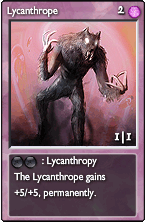
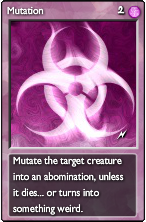

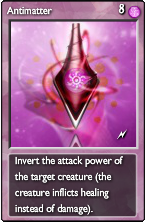
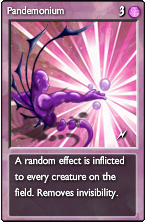
Nova: As the backbone of the powerful rainbow deck archetypes, there is a good reason why Nova is so popular and well known. A quick burst of 1 quanta to all elements may not do much in a mono Entropy deck, but that quick gain of quanta is exactly what a rainbow deck needs, getting both useful quanta and speed at the same time. In mono settings, it can be used to power mutants or Lycanthrope. Upgraded, it generates 2 of every quanta, spawning an entire archetype of decks, the SuperNovabow, which, while not being covered here, are very powerful decks. Don't chain multiple in a turn unless the Singularity gained can quickly be dealt with.
Lycanthrope: Doesn't look too amazing at a glance with meager 1|1 stats, but with either nova, a Quantum Pillar, or even a ![]() mark splash, it can quickly turn into a decent 6|6 mid range hitter. It is for this reason that Lycanthrope most often fills out the
mark splash, it can quickly turn into a decent 6|6 mid range hitter. It is for this reason that Lycanthrope most often fills out the ![]() /
/ ![]() parts of most unupped rainbows.
parts of most unupped rainbows.
Mutation: Lady luck may or may not be with the user when they play Mutation. Mutation has a 50% of turning any creature into a 5|5 abomination or 10% of insta-killing a creature, making quite fantastic for creature control. Unupped, it has a 40% of turning a creature into a mutant while upped, it has a 100% of creating a mutant. Mutants are often random creatures with a small random stat boost and a random skill. An interesting synregy for Mutation is to chain Novas to create a Singularity and then mutating the Singularity into a useful mutant.
Discord: The bane of many decks. Discord is a single card that can effectively shut down monos, duos, and trios alike, with the more elements being added on, the more damage taken from Discord. Discord scrambles 9 random quanta from the opponent, being extremely powerful quanta control. If possible, combine Discord with other denial cards like Earthquake or Devourer. Has absolutely fantastic synergy with Black Hole.
Antimatter: Forget all the other creature control cards. Lightning? BB? Rage pot? None of these stand up to the control of Antimatter. While Antimatter doesn't kill a creature, it makes a creature heal instead of doing damage, turning a 10 attack dragon into a -10 attack dragon, creating twice the targetted creature's attack hp gap every turn. Careful usage of Antimatter can net an effective shut down of two creatures with one spell, but the downside to this wonderful spell is that it costs four times as much as the other creature control cards, and it doesn't affect most creature skills.
Pandemonium: An area of effect creature control card that captures the randomness of Entropy. Pandemonium affects all creatures (only the opponent's if upgraded) with a random effect from Chaos Seed. These can range from bolt spells, to Gravity Pull, to Parallel Universe. Decks that don't have many creatures, resistant creatures, or lucky players may find that Pandemonium fits up their niche for cheap and affordable creature control. Synergizes great with Voodoo Doll and Immortal creatures.
 Fire
Fire 
Fire is the element of brutality, offense and speed. Nearly all of Fire's creatures are speedy glass cannons, having very little defense but packing in plenty of damage. Ironically, in addition to the deadly offense that Fire packs, it also has some of the best control in the game, having a simple permanent control card, and having over 5 creature control cards. Combinations of damage, speed, and control shape up to make Fire one of the more powerful elements because of its completeness and ruthlessness.
Cards worthy of note: Lava Golem, Immolation, Fire Bolt, Phoenix, Deflagration, Seraph
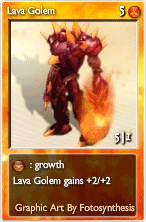

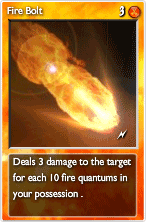

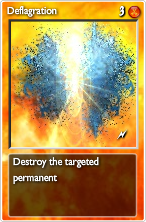

Lava Golem: A staple in immolation rushes, as well as in mono fire rushes, a Lava Golem comes into play with high attack but only a single hp. However, if it is kept alive for a few turns and steadily fed ![]() quanta that can be supplied with a mark, the Golem can gain +2|+2 every single turn, quickly resulting into a nigh-indestructible goliath of damage.
quanta that can be supplied with a mark, the Golem can gain +2|+2 every single turn, quickly resulting into a nigh-indestructible goliath of damage.
Immolation: Fire's one card that catapults it leagues ahead of other elements in terms of speed. By sacrificing one creature, Immolation generates 6 (8 if upped) ![]() and 1 quanta of every other element. This immense burst of quanta can allow a Lava Golem to hit the field before even ending the first turn. Photons and Sparks are often used as immolation fodder because of their free cost. Immolation also allows a user to build a rainbow deck because combined with Nova, the quanta gained in other elements can quickly be transformed into useful cards to play.
and 1 quanta of every other element. This immense burst of quanta can allow a Lava Golem to hit the field before even ending the first turn. Photons and Sparks are often used as immolation fodder because of their free cost. Immolation also allows a user to build a rainbow deck because combined with Nova, the quanta gained in other elements can quickly be transformed into useful cards to play.
Fire Bolt: Fire's arsenal of creature control is one of the greatest in the game. Along with fire bolt, there is Rage Potion, that gives a creature +5|-5 (the 5s are 6s if upped), but is more often used as a Lightning for one shots. Players who like fire bolt can consider Rain of Fire, which is equivalent to striking every opposing creature with a single fire bolt. Fire's elemental shield, the Fire Shield damages all attacking creatures for 1 hp each time they attack. A mono Fire deck should never put up a fire shield if the opponent has Steal. If stolen, fire shield counters every single one of Fire's creatures. Finally, fire bolt can be used as direct damage as well, able to deal a maximum of 24 damage in a single spell to the opponent. This has led to many stall decks built around using fire bolt and a huge influx of ![]() to win the game in a single turn.
to win the game in a single turn.
Phoenix: While Phoenix seems like the stereotypical glass cannon for fire, it comes with a very useful ability that allows itself to revive itself for 1 ![]() if killed. It is in this way that Fire also has some anti-control capabilities as well, with a creature that can continuously resurrect itself if killed. Upgraded, Phoenix fills a small-mid range hitter role instead of the high mid range hitter role it had unupped, but upgraded, Minor Phoenix is much more efficient with a 2/1 attack to damage ratio as opposed to the 1/1 attack to damage ratio Phoenix has.
if killed. It is in this way that Fire also has some anti-control capabilities as well, with a creature that can continuously resurrect itself if killed. Upgraded, Phoenix fills a small-mid range hitter role instead of the high mid range hitter role it had unupped, but upgraded, Minor Phoenix is much more efficient with a 2/1 attack to damage ratio as opposed to the 1/1 attack to damage ratio Phoenix has.
Deflagration: Simple, yet effective. The ability to destroy an enemy permanent is invaluable at times. Perhaps an annoying Dimensional Shield came up, or an Owls Eye poised to snipe down precious creatures. Deflagration vanquishes any opposing unprotected permanent, and its cheap cost means that it can be used in decks other than mono Fire, or even splashed into decks with a ![]() mark.
mark.
Seraph: Perhaps the medium between Phoenix and Crimson Dragon, Seraph doesn't have as much attack efficiency as the dragon, and its defensive abilities aren't as great as Phoenix's, but Seraph does come into play quite efficient and an interesting ability that allows it to protect itself indefinitely as long as it gets 1 ![]() per turn.
per turn.
 Gravity
Gravity 
Bulky, sturdy, Gravity. Gravity is the most defensive and resistant of all the elements, but what it has in defense, it lacks in offense. Gravity's defensive stance is exemplified by the high hp most of its creatures have, and cards that make use of high hp values. Gravity is usually used in defensive stall decks, although powerful hitters like charger or titan can change that.
Cards worthy of note: Sapphire Charger, Titan, Otyugh, Acceleration, Catapult, Black Hole
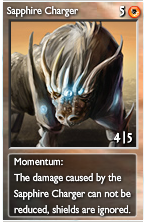
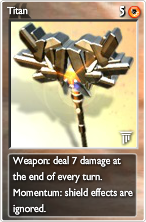
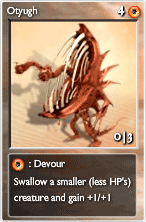
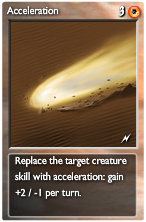
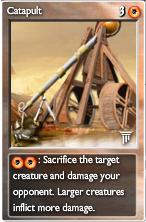

Sapphire Charger: The card Gravity turns to for most of its damage dealing. Graviton Mercenary is too ineffective for offense and Graviton Fire Eater requires ![]() and takes a while to start up. Charger is a great card in that not only does it have decent 4|5 stats, but it also comes with Momentum, making it able to ignore opposing enemy shields. Upgraded, Elite Charger has 7|5 stats for 5
and takes a while to start up. Charger is a great card in that not only does it have decent 4|5 stats, but it also comes with Momentum, making it able to ignore opposing enemy shields. Upgraded, Elite Charger has 7|5 stats for 5 ![]() , a very great deal and one of the greatest rushing cards in the game.
, a very great deal and one of the greatest rushing cards in the game.
Titan: Titan too, comes with momentum like charger, but the thing that is amazing about Titan is that when flying with Flying Weapon, Titan has an astounding 50 hp. 50, half of what a player has. A flying titan is almost virtually indestructible with that much amount of health, and can be used with cards that make use of high hp, like Rage Potion, Acceleration, Liquid Shadow, and Catapult.
Otyugh: Otyugh is a creature that can devour a creature every single turn. The only requirement for devouring is that Oty has to have higher hp than the targetted creature. Piling on cards like Blessing or Plate Armor on Oty can greatly increase its lethality. Otyugh is mostly used as a very powerful control card, but its offense is lacking, so players who center too much on Otys must find some way to do enough damage with cards like Vulture or Boneyard.
Acceleration: Acceleration is a card that takes advantage of Gravity's sturdy creatures. When applied on a creature, the creature loses previous skills and loses hp but gains attack before they attack each turn. Unupgraded, the attack gain is 2, but upgraded, the attack gain is 3, meaning a 7|5 charger can become a 19|1 charger in 4 turns. Acceleration can also be used as soft creature control to either lobotomize enemy creatures, or kill really fragile creatures.
Catapult: Another card taking advantage of high hp creatures. Catapult allows a user to sacrifice one of their own creatures to deal instant (100*HP)/(100+HP) damage to the opponent, not blocked by shields. A thrown Armagio does 20 (23 if upped) damage, and a flying titan does 34. Catapult is also useful for getting rid of creatures that aren't needed, such as a delayed charger, or antimattered titan. Catapult also has synergy with Basilisk Blood because of increased damage, and oddly enough, Freeze. A frozen creature does 1.5* the damage a non-frozen creature with the same HP would do, allowing a thrown frozen titan to do 51 damage, just over half the hp of an opponent. Poisoned creatures also give the opponent the number of poison counters they had at the time of launch.
Black Hole: Gravity's card of choice when it comes to denial. 3 quanta of every single element is drained from the opponent and added to the user's HP. This card seems innocent enough against mono decks, but can hinder a duo or trio, and absolutely decimates rainbow decks. Discord's quanta scrambling are almost perfect with black hole. Scrambling an opponent's quanta randomly and then suddenly absorbing all of them into HP is a very powerful denial method. Blocked by Sanctuary like discord is.
 Life
Life 
The element of Life is all about cheap, efficient, fragile creatures that swarm the opponent, but it also has a stall worthy defensive side as well, based on healing. However, what Life has in offense and defense, Life lacks in the control department. Life only has one creature control card (and then it is a weak, slow, and expensive shield), and no permanent control whatsoever. This can put Life into an awkward spot, especially when up against Wings or Dimensional Shield. Despite these hurdles, Life can be a very potent element when played correctly.
Cards worthy of note: Adrenaline, Horned Frog, Empathic Bond, Mitosis, Rustler, Thorn Carapace
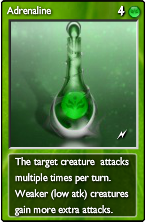
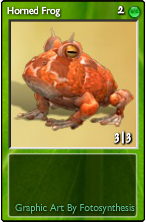
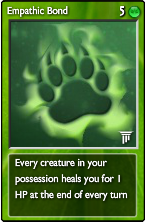
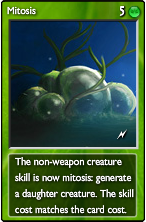
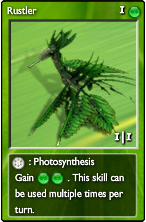
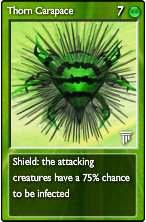
Adrenaline: Life perhaps lacks a good mid range hitter, but this spell fits in that role. Adrenaline on a creature causes a creature to attack multiple times per turn, doing up to four times their usual damage. It has especially good synergy with creatures that have 3 or 8 attack, granting them up to 9 extra damage. Be warned that adrenaline causes a creature to attack many times, so shield effects and poison damage will apply many times per turn for the targetted creature.
Horned Frog: Cheap and efficient. The frog is perhaps the card that best symbolizes Life. It is a simple card with no ability, but it comes with decent stats at 3|3 for only 2 ![]() . Its 3 attack is perfect for adrenaline, and with a two card combo consisting of 6
. Its 3 attack is perfect for adrenaline, and with a two card combo consisting of 6 ![]() , one can get a frog that deals 12 damage per turn, provided there are no shields. Upgraded, the frog is one of the most efficient creatures in the game, with fantastic stats of 5|3 for still only 2
, one can get a frog that deals 12 damage per turn, provided there are no shields. Upgraded, the frog is one of the most efficient creatures in the game, with fantastic stats of 5|3 for still only 2 ![]() . This makes frog a great candidate for creature spamming, such as with Fractal or Mitosis. If one wishes for a more sturdy attacker, Cockatrice is slightly more expensive than frog, but comes with more hp.
. This makes frog a great candidate for creature spamming, such as with Fractal or Mitosis. If one wishes for a more sturdy attacker, Cockatrice is slightly more expensive than frog, but comes with more hp.
Empathic Bond: Life should bring about thoughts of healing, and Empathic Bond is a great card for healing. Every turn, each bond heals the user for however many number of creatures they have for hp. If the user had 3 bonds and 5 creatures for example, the user would gain 15 hp per turn. Bond works great with creature spamming, so using lots of cheap creatures like frog or cockatrice, or using a card that breaks the 6 card rule like mitosis or fractal also works. For players who want a faster version of healing, Heal provides a one time quick burst of life gain, whereas bond provides more passive healing over time.
Mitosis: Life's version of breaking the 6 card limit. It is much slower than fractal, but it is cheaper. It can also be used as an extremely soft version of creature control, since it replaces whichever targetted creature's ability with mitosis. The more expensive the targetted creature, the more the skill will cost.
Rustler: This little cute leaf dragon fits a specialized role in the acceleration of quanta. With the potential to turn 1 ![]() into 2
into 2 ![]() as many times as possible per turn, some Life decks use a
as many times as possible per turn, some Life decks use a ![]() mark but light pillars and rustlers to provide quanta. These fragile creatures substantially help Life's speed if chosen to be used with
mark but light pillars and rustlers to provide quanta. These fragile creatures substantially help Life's speed if chosen to be used with ![]() generators.
generators.
Thorn Carapace: Life's only mode of creature control. Unfortunately, it comes into play quite late, with its high cost, and takes a while to kill opposing creatures. Its a uncommonly seen shield, but it does have a role, and an enchanted carapace is often used in ragequit or heavy stall decks that focus on killing off all of an opponent's creatures. Emerald Shield would probably be better for pure protection in a normal game, as thorn carapace only is useful if you have enough stall power.
 Light
Light 
Light is also a defensive element along with ![]() and
and ![]() , but unlike Gravity, Light doesn't seem to pull any punches in its offense, as it comes with a wide arsenal of creatures that are sturdy and powerful. However, Light is still most known for its defensive stalling ability, coming with the most healing cards out of all the elements including the very powerful rare card, Miracle, which can bring a user's hp to near full.
, but unlike Gravity, Light doesn't seem to pull any punches in its offense, as it comes with a wide arsenal of creatures that are sturdy and powerful. However, Light is still most known for its defensive stalling ability, coming with the most healing cards out of all the elements including the very powerful rare card, Miracle, which can bring a user's hp to near full.
Cards worthy of note: Sanctuary, Crusader, Miracle, Hope, Blessing, Morning Star
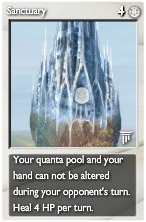
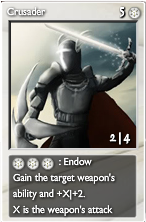
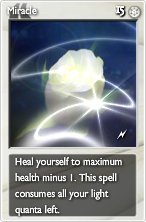
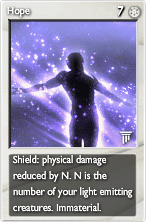
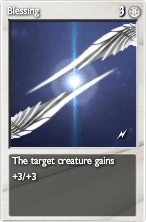
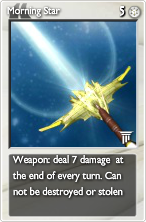
Sanctuary: A very desirable card, Sanctuary is a solely defensive permanent that in addition to generating 4hp per turn, stops the effects of Devourer, Discord, Black Hole, Nightmare, and Silence. This permanent is able to shut down many denial decks with its simple presence, and the 4hp gain per turn never hurts either. Be warned that using this in conjunction with Solar Shield or Dissipation Shield will negate the shield's effect.
Crusader: Light's version of the popular Flying Weapon card. Crusader fits into the mid range hitter for Light, but its interesting ability allows it to basically copy the effects of any targettable weapon. While Crusader costs more than Flying Weapon and Animate Weapon and forces the user to use at least a duo Light deck, Crusader gets to keep its original attack when endowing, making a Crusader endowing a Vampire Stiletto much better than a flying stiletto by itself. For Light players who want just pure damage without any shenanigans, Pegasus is a choice, as is Archangel (Upgraded Guardian Angel) and Golden Dragon.
Miracle: Another hair-tearing, frustrating card like Dimensional Shield. Miracle allows a user to instantly heal to maximum hp-1 in exchange for all of a user's ![]() . A wise player will have used up all the
. A wise player will have used up all the ![]() they can before they cast this card. In most occasions, Miracle will set the user's hp to 99, but when paired up with Stone Skin or other cards that increase maximum hp, this can be a very potent recovery card. Even in normal circumstances, this card is basically a second life, able to turn the tide of the game easily.
they can before they cast this card. In most occasions, Miracle will set the user's hp to 99, but when paired up with Stone Skin or other cards that increase maximum hp, this can be a very potent recovery card. Even in normal circumstances, this card is basically a second life, able to turn the tide of the game easily.
Hope: Light is the element with the most amount of shields, and all of them are insanely defensive. Solar Shield reduces 1 damage, and basically turns all enemy creatures into light pillars. Mirror Shield is an extremely cheap shield that is immaterial and reflects spell damage. Hope is also an immaterial shield, but the damage it blocks is based on the number of light emitting creatures on the field. Without using Luciferin, only two creatures naturally emit light, Firefly, and the upgraded Ray of Light. Hope is especially powerful when paired up with Ray of Light and fractal, allowing for a field full of creatures that power hope, making it have a potential of 23 (24 if upped) damage reduction in addition to being PC-proof.
Blessing: There aren't many buff cards in the game, so Blessing tends to stand out. For a price of 3 (2 if upped) ![]() , a user can increase the stats of a creature by +3|+3. 3 attack is always great to have, but an extra 3hp means that whichever creature is buffed is often pushed out of most CC range. Blessing works great with another card that Light has, Pegasus. Since Pegasus dives to double damage, a +3atk is essentially a +6atk boost to it, making blessing twice as efficient. Be warned that Gravity Shield might counter Blessing, as does Reverse Time or Antimatter.
, a user can increase the stats of a creature by +3|+3. 3 attack is always great to have, but an extra 3hp means that whichever creature is buffed is often pushed out of most CC range. Blessing works great with another card that Light has, Pegasus. Since Pegasus dives to double damage, a +3atk is essentially a +6atk boost to it, making blessing twice as efficient. Be warned that Gravity Shield might counter Blessing, as does Reverse Time or Antimatter.
Morning Star: Light's elemental weapon of choice is a gleaming sword that deals decent damage and starts out protected. While it may seem costly, Morning Star's protected status means that it can't be stolen or destroyed, but neither can it be endowed. A great combo with this card is Flying Weapon, since one of these flying swords keeps the immaterial status.
 Time
Time 
Time is quite a funny element in that at first glance, nothing seems to really stick out. No massive attackers, no permanent control, soft creature control...underneath that surface, Time is an element that has a rather gimmicky nature, but that does not detract from its strength. One of Time's greatest advantages is that it has the ability to draw more than one card per turn, greatly speeding up larger decks.
Cards worthy of note: Sundial, Pharaoh, Eternity, Ghost of the Past, Golden Hourglass, Deja Vu


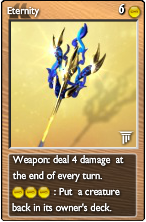
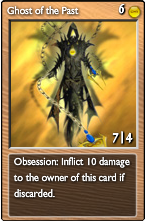
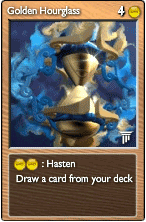
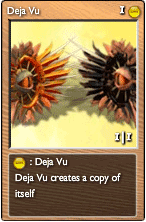
Sundial: Another one of those really useful stall cards. It has an amazingly cheap cost (free when upgraded!), and it basically stops all of the opponent's creatures from attacking for one turn. In exchange for this, the user's creatures don't attack either, but clever users of Sundial will often be using creatureless or decks with little creatures, instead relying on poison or weapon damage, two things not blocked by Sundial. Sundial also allows the user to draw an extra card for the price of 1 ![]() the next turn, making this a stall card that also helps speed up a stall.
the next turn, making this a stall card that also helps speed up a stall.
Pharaoh: Time's rare version of Firefly Queen. Instead of spawning a Firefly each turn, Pharaohs spawn a Scarab every turn. While more expensive than FFQ, Pharaohs only require 1 element to start producing creatures, and a swarm of Scarabs is very hard to get rid of. Additionally, a swarm of scarabs can easily be used as CC, devouring opposing creatures if they are provided with ![]() . For scarab users who don't have many copies of this rare card, Fractal also works great with Scarab.
. For scarab users who don't have many copies of this rare card, Fractal also works great with Scarab.
Eternity: At first glance, this seems like a very expensive and cumbersome weapon that doesn't do much damage, but the true power of this lies in its ability. For 3 ![]() it grants indefinite casts of Reverse Time, a soft CC card that moves a creature onto its owner's deck. With sufficient
it grants indefinite casts of Reverse Time, a soft CC card that moves a creature onto its owner's deck. With sufficient ![]() , an Eternity can easily lock down the opponent's field because no matter how sturdy a summoned creature is, 3
, an Eternity can easily lock down the opponent's field because no matter how sturdy a summoned creature is, 3 ![]() and it disappears back onto the opponent's deck, also denying them of their next draw. Eternity can also be used to continuously rewind a free card like Photon, allowing a player to keep playing indefinitely since their deck will always be replenished by the rewound card.
and it disappears back onto the opponent's deck, also denying them of their next draw. Eternity can also be used to continuously rewind a free card like Photon, allowing a player to keep playing indefinitely since their deck will always be replenished by the rewound card.
Ghost of the Past: Time's midrange hitter of choice. 6 ![]() for 7|4 (7
for 7|4 (7 ![]() for 9|4 upped) is absolutely fantastic, but its ability might put off players from using it. However, one card synergizes spectacularly with ghost, and that card is Nightmare. By forcing Ghost into the opponent's hand, they will be forced to discard, and if they discard the ghost, they instantly take 10 (13 if upped) damage. The very concept of a popular deck, the ghostmare, focuses on nightmaring ghosts into the opponent's hand, using Reverse Time to remove opposing creatures, and deal damage with ghosts while the opponent is locked down. Ironically, ghost is also a great candidate for Fractal, being found in some
for 9|4 upped) is absolutely fantastic, but its ability might put off players from using it. However, one card synergizes spectacularly with ghost, and that card is Nightmare. By forcing Ghost into the opponent's hand, they will be forced to discard, and if they discard the ghost, they instantly take 10 (13 if upped) damage. The very concept of a popular deck, the ghostmare, focuses on nightmaring ghosts into the opponent's hand, using Reverse Time to remove opposing creatures, and deal damage with ghosts while the opponent is locked down. Ironically, ghost is also a great candidate for Fractal, being found in some ![]() +
+ ![]() duos. However, Time users who use this card must be very careful about quanta or hand denial, lest they find themselves forced to discard.
duos. However, Time users who use this card must be very careful about quanta or hand denial, lest they find themselves forced to discard.
Golden Hourglass: One of the most recognized cards for its ability to increase the user's draw speed. Unupgraded, it might seem a bit expensive, but when upgraded, users merely pay 1 ![]() per turn to draw an extra card, netting a large increase in speed. For players who want an instant draw without delay or the initial playing cost, Precognition instantly allows a player to draw and sneak a peek at the opponent's hand.
per turn to draw an extra card, netting a large increase in speed. For players who want an instant draw without delay or the initial playing cost, Precognition instantly allows a player to draw and sneak a peek at the opponent's hand.
Deja Vu: An odd little critter with low stats, Deja Vu is often overlooked. Deja Vu's ability allows it to instantly split, replicating itself perfectly (besides the airborne status). Status effects and buffs are also transferred, so a 4|4 Deja Vu with Adrenaline splits into two Deja Vus with 4|4 and adrenaline. Deja Vu is in this way a prime target for buff cards. Deja Vu's replication creates two creatures without abilities, so if one wants to use the skill indefinitely, Reverse Time must be used. However, extra copies can also be useful for Immolation, Mutation, Luciferin and Hope, and Empathic Bond.
 Water
Water 
Water, like Time, doesn't seem to have anything stand out at a glance, but Water is actually the element with the most CC in the game. In addition to control, Water has quite a few specialized creatures, such as squid, chrysaora, and the steam machine.
Cards worthy of note: Nymphs Tears, Arctic Squid, Toadfish, Steam Machine, Ice Shield, Chrysaora
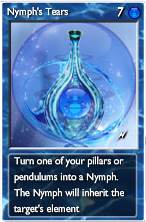
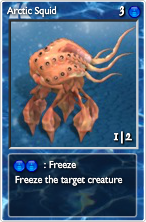
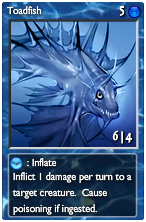

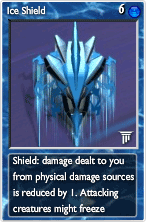

Nymphs Tears: Water's alchemy spell is a rather gimmicky card that allows a pillar to be turned into a nymph. An opponent's pillar becomes a nymph for them, and a user's pillar becomes a nymph on his or her side. The nymph that comes out is dependent on what element the pendulum or pillar that this was cast on, with upped pillars/pends producing upped nymphs. The main use of this card is to summon the ultra rare and expensive nymphs at a cheap and affordable price.
Arctic Squid: A rare card, Squid provides much control for the element of water, allowing infinite casts of Freeze. A single squid can potentially shut down an ememy's field provided with enough ![]() . Mind Flayer can be seen as the common version of this card, providing soft control (lobotomization as opposed to freezing).
. Mind Flayer can be seen as the common version of this card, providing soft control (lobotomization as opposed to freezing).
Toadfish: Great mid range hitter for unupped water. 6|4 stats for 5 ![]() is great, and it comes with some CC as well. Upgraded, this becomes a completely different card, gaining -3|+1 stats but poison. Upped Puffer Fish enjoys synergy with Adrenaline, but from an purely offensive point of view, an upgraded Blue Crawler does better for damage dealing in upped Water.
is great, and it comes with some CC as well. Upgraded, this becomes a completely different card, gaining -3|+1 stats but poison. Upped Puffer Fish enjoys synergy with Adrenaline, but from an purely offensive point of view, an upgraded Blue Crawler does better for damage dealing in upped Water.
Steam Machine: A sturdy, but odd card. With zero attack to start with, Steam Machine seems pretty slow, but with 2 ![]() per turn, it gains +4 attack per turn, making it the fastest growth creature. It's 6 (15 upped!) hp means that it is relatively safe from CC, and the high hp also synergizes with Fire's Rage Potion making Steam Machine a nice bridge for Water and Fire.
per turn, it gains +4 attack per turn, making it the fastest growth creature. It's 6 (15 upped!) hp means that it is relatively safe from CC, and the high hp also synergizes with Fire's Rage Potion making Steam Machine a nice bridge for Water and Fire.
Ice Shield: In terms of damage reduction, Ice Shield is probably the best shield. Not only does it come with 1 (2 if upped) damage reduction, but each attacking creature has a 30% to be frozen for 3 turns. Not only does this stop the creatures from using their abilities, but it dramatically cuts down the damage taken. All in all, Ice Shield averages to block around 47% of creature attacks in addition to the damage reduction it has. A very defensive shield that functions as soft CC.
Chrysaora: At first glance, the 0atk seems off-putting, but Chrysaora is Water's way of getting around shields. This creature can turn 1 ![]() into one poison counter on the opponent each turn, a bit ironic since Water also has Purify, the counter to poisons. Players who use Chrysaora will be glad to find they can make use of its 0atk with Sundial and how Chrysaora isn't affected by shields. For players who are willing a bit more risk to their Chrysaora, upping the creature gives it 2 attack, and while it triples the damage output, opposing shields may pose a problem.
into one poison counter on the opponent each turn, a bit ironic since Water also has Purify, the counter to poisons. Players who use Chrysaora will be glad to find they can make use of its 0atk with Sundial and how Chrysaora isn't affected by shields. For players who are willing a bit more risk to their Chrysaora, upping the creature gives it 2 attack, and while it triples the damage output, opposing shields may pose a problem.
Overview
Ranking
| Element | Offense | Defense | Control | Speed |
| ** | **** | ** | ** | |
| *** | **** | ** | *** | |
| ** | ** | **** | *** | |
| **** | *** | * | **** | |
| ** | *** | * | ** | |
| ** | ** | *** | ** | |
| ***** | * | ***** | **** | |
| * | **** | *** | * | |
| **** | ** | * | ***** | |
| ** | ***** | * | ** | |
| *** | ** | *** | **** | |
| *** | *** | **** | *** |